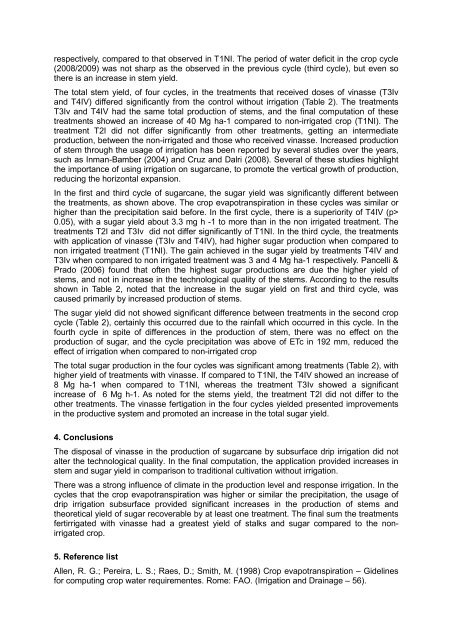poster - International Conference of Agricultural Engineering
poster - International Conference of Agricultural Engineering
poster - International Conference of Agricultural Engineering
You also want an ePaper? Increase the reach of your titles
YUMPU automatically turns print PDFs into web optimized ePapers that Google loves.
espectively, compared to that observed in T1NI. The period <strong>of</strong> water deficit in the crop cycle<br />
(2008/2009) was not sharp as the observed in the previous cycle (third cycle), but even so<br />
there is an increase in stem yield.<br />
The total stem yield, <strong>of</strong> four cycles, in the treatments that received doses <strong>of</strong> vinasse (T3Iv<br />
and T4IV) differed significantly from the control without irrigation (Table 2). The treatments<br />
T3Iv and T4IV had the same total production <strong>of</strong> stems, and the final computation <strong>of</strong> these<br />
treatments showed an increase <strong>of</strong> 40 Mg ha-1 compared to non-irrigated crop (T1NI). The<br />
treatment T2I did not differ significantly from other treatments, getting an intermediate<br />
production, between the non-irrigated and those who received vinasse. Increased production<br />
<strong>of</strong> stem through the usage <strong>of</strong> irrigation has been reported by several studies over the years,<br />
such as Inman-Bamber (2004) and Cruz and Dalri (2008). Several <strong>of</strong> these studies highlight<br />
the importance <strong>of</strong> using irrigation on sugarcane, to promote the vertical growth <strong>of</strong> production,<br />
reducing the horizontal expansion.<br />
In the first and third cycle <strong>of</strong> sugarcane, the sugar yield was significantly different between<br />
the treatments, as shown above. The crop evapotranspiration in these cycles was similar or<br />
higher than the precipitation said before. In the first cycle, there is a superiority <strong>of</strong> T4IV (p><br />
0.05), with a sugar yield about 3.3 mg h -1 to more than in the non irrigated treatment. The<br />
treatments T2I and T3Iv did not differ significantly <strong>of</strong> T1NI. In the third cycle, the treatments<br />
with application <strong>of</strong> vinasse (T3Iv and T4IV), had higher sugar production when compared to<br />
non irrigated treatment (T1NI). The gain achieved in the sugar yield by treatments T4IV and<br />
T3Iv when compared to non irrigated treatment was 3 and 4 Mg ha-1 respectively. Pancelli &<br />
Prado (2006) found that <strong>of</strong>ten the highest sugar productions are due the higher yield <strong>of</strong><br />
stems, and not in increase in the technological quality <strong>of</strong> the stems. According to the results<br />
shown in Table 2, noted that the increase in the sugar yield on first and third cycle, was<br />
caused primarily by increased production <strong>of</strong> stems.<br />
The sugar yield did not showed significant difference between treatments in the second crop<br />
cycle (Table 2), certainly this occurred due to the rainfall which occurred in this cycle. In the<br />
fourth cycle in spite <strong>of</strong> differences in the production <strong>of</strong> stem, there was no effect on the<br />
production <strong>of</strong> sugar, and the cycle precipitation was above <strong>of</strong> ETc in 192 mm, reduced the<br />
effect <strong>of</strong> irrigation when compared to non-irrigated crop<br />
The total sugar production in the four cycles was significant among treatments (Table 2), with<br />
higher yield <strong>of</strong> treatments with vinasse. If compared to T1NI, the T4IV showed an increase <strong>of</strong><br />
8 Mg ha-1 when compared to T1NI, whereas the treatment T3Iv showed a significant<br />
increase <strong>of</strong> 6 Mg h-1. As noted for the stems yield, the treatment T2I did not differ to the<br />
other treatments. The vinasse fertigation in the four cycles yielded presented improvements<br />
in the productive system and promoted an increase in the total sugar yield.<br />
4. Conclusions<br />
The disposal <strong>of</strong> vinasse in the production <strong>of</strong> sugarcane by subsurface drip irrigation did not<br />
alter the technological quality. In the final computation, the application provided increases in<br />
stem and sugar yield in comparison to traditional cultivation without irrigation.<br />
There was a strong influence <strong>of</strong> climate in the production level and response irrigation. In the<br />
cycles that the crop evapotranspiration was higher or similar the precipitation, the usage <strong>of</strong><br />
drip irrigation subsurface provided significant increases in the production <strong>of</strong> stems and<br />
theoretical yield <strong>of</strong> sugar recoverable by at least one treatment. The final sum the treatments<br />
fertirrigated with vinasse had a greatest yield <strong>of</strong> stalks and sugar compared to the nonirrigated<br />
crop.<br />
5. Reference list<br />
Allen, R. G.; Pereira, L. S.; Raes, D.; Smith, M. (1998) Crop evapotranspiration – Gidelines<br />
for computing crop water requirementes. Rome: FAO. (Irrigation and Drainage – 56).

















